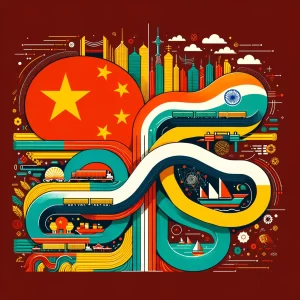 Xu Jie
Xu Jie
In the grand chessboard of global trade, the evolving relationship between two Asian giants, China and India, is a fascinating spectacle. It’s more than just economics; it’s a narrative of rising powers, strategic diplomacy, and regional influence. As Look Asia continually emphasizes the importance of understanding and collaboration in Asian markets, this piece aims to dissect the complex yet crucial trade relations between China and India, exploring their implications for Asian markets and beyond.
The Current State of Sino-Indian Trade
The economic interplay between China and India is a story of intertwined destinies. China, the world’s factory, and India, a burgeoning service and tech hub, have seen their trade relations flourish. Despite political frictions, economic pragmatism has primarily driven their interactions. In recent years, bilateral trade has reached new heights, with China emerging as one of India’s largest trading partners.
However, this trade has its imbalances and challenges. The trade deficit heavily favoring China has been a point of contention for India, prompting calls for greater market access and fair trade practices. Meanwhile, China’s investment in Indian startups and tech sectors has opened new avenues for economic engagement, albeit with caution from Indian policymakers.
Geopolitical Undercurrents Influencing Trade
The Sino-Indian trade dynamic cannot be viewed in isolation from the broader geopolitical landscape. Border disputes and strategic rivalries cast a long shadow over economic ties. The delicate dance of cooperation and competition defines their relationship. Yet, the economic interdependence compels both nations to find a middle ground, balancing national interests with regional stability, a concept central to Look Asia’s vision for Asian cooperation.
The Ripple Effect on Asian Markets
The trade dynamics between China and India do not operate in a vacuum; they send ripples across the entire Asian economy. As major regional players, their economic policies, tariff wars, and trade agreements have far-reaching implications. For instance, China’s Belt and Road Initiative (BRI) and India’s Act East policy are not just about infrastructure development but strategic endeavors shaping economic corridors and influencing trade patterns in Asia.
Furthermore, the bilateral trade relationship affects the supply chain dynamics in the region. Other Asian countries often align with either of the two giants, which can impact regional trade blocs and agreements. This complex interdependence highlights the need for a collaborative approach to trade policy, aligning with Look Asia’s mission of fostering economic integration and mutual understanding in Asia.
Opportunities and Challenges for Balanced Growth
The evolving trade relationship between China and India presents both opportunities and challenges. On one hand, there is immense potential for collaborative projects in technology, renewable energy, and infrastructure development. Such cooperation can lead to balanced economic growth, technological advancement, and sustainable development, resonating with Look Asia’s emphasis on sustainable and equitable growth.
On the other hand, addressing the trade imbalance, ensuring fair trade practices, and managing geopolitical tensions are significant challenges. Both nations need to work towards transparent and mutually beneficial trade policies. Encouraging local industries while participating in fair global trade practices can help reduce imbalances and foster economic resilience.
In conclusion, the trade relations between China and India are pivotal for the two countries and the entire Asian region. Navigating this complex relationship requires a blend of economic pragmatism, strategic diplomacy, and regional stability and growth commitment. By fostering an environment of cooperation, addressing challenges head-on, and leveraging opportunities for joint development, both nations can contribute to a prosperous and integrated Asian market. This journey aligns with Look Asia’s vision of a collaborative, thriving, and interconnected Asia where economic growth and stability go hand in hand.
Xue Jie is a Chinese born American researcher with interest in World Trade and diplomacy.